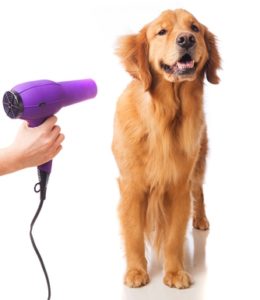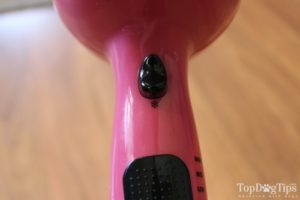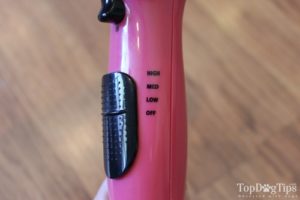Bathing your dog at home is a great way to save money on professional grooming expenses. Even if you just bathe your pet between professional haircuts, it could add up to hundreds in savings over the course of the year. Just remember that you'll need to know how to shop for the right supplies, including how to choose a safe dog dryer.
Most pet owners think allowing their dog to air dry is just fine, especially if he can go outside and not leave a soggy mess inside the house. Actually, allowing your dog to air dry is dangerous.
 If your dog is not properly dried after a bath, fungus could grow between the pads of his paws or under his armpits. Leaving the coat wet could also lead to matting in long-haired breeds. A wet coat will also hold moisture to the skin, which may cause irritation.
If your dog is not properly dried after a bath, fungus could grow between the pads of his paws or under his armpits. Leaving the coat wet could also lead to matting in long-haired breeds. A wet coat will also hold moisture to the skin, which may cause irritation.
While the health risks are quite concerning, a dog left to air dry can also be a complete pain in the butt. They'll try to dry themselves on your furniture, carpeting and bedding by rolling around and leaving their wet dog smell on all of your belongings. Even worse, if you let them outside they'll roll around in the dirt and get dirty all over again!
So, now that you know why it's important to dry your dog, let's talk about how to choose a safe dog dryer. If you try to use the old hairdryer you have sitting in your bathroom closet, you run the risk of singing your pet's coat or burning him.
You can use a hair dryer made for humans, but it's best to buy one made specifically for dogs if you can afford it.
Are you new to bathing your dog at home? Whether you plan on using a towel or a dryer, I share some tips in the video guide below. It's a great place to start if you're a beginner at DIY dog bathing.
FULL GUIDE: How To Dry A Dog After Bathing – Full Step-by-Step Instructions
How to Choose A Safe Dog Dryer
As I mention in the video guide at the top of this article, if you're a professional grooming or you groom a lot of dogs in your home, it's best to invest the money in a professional dog dryer. These will cost you hundreds (if not thousands) of dollars, but they're well worth the money.
This guide is for the DIY groomer that only cares for their own pack. You can get away with using a hair dryer for humans, but you have to be VERY careful about the one that you select.
Your best bet is buy a hair dryer that is specifically made for dogs.
 The first thing you need to know when learning how to choose a safe dog dryer is that you have to choose one that blows cold air. As you'll see, I use a hair dryer that is made for humans. It has a small button that can be held down to enable it to blow cold air.
The first thing you need to know when learning how to choose a safe dog dryer is that you have to choose one that blows cold air. As you'll see, I use a hair dryer that is made for humans. It has a small button that can be held down to enable it to blow cold air.
The reason that this feature is so important is because your pooch can't tell you when the dryer gets too hot. When you're drying your own hair, you can feel that your scalp is getting too hot and move the dryer. If your dog can't tell you when he's feeling the heat, it's quite likely that you'll end up burning him – or at the very least making him very uncomfortable.
It's also important to find a dryer with multiple speeds. If your dog has thick fur, you'll want a higher speed. Likewise, if your pet has thin or fine hair, you'll want a lower speed that won't irritate his skin.
 Professional dryers are more expensive, but they also work much faster. They're specifically made for dogs, so it's safe to say they're going to have safety features in place to prevent injury to your pet.
Professional dryers are more expensive, but they also work much faster. They're specifically made for dogs, so it's safe to say they're going to have safety features in place to prevent injury to your pet.
Floor or tabletop dryers are better for multi-pet households or owners with a pet that needs frequent baths. Not only will they save time, they're also much easier to use. Dryers made specifically for pets also tend to be much quieter, to prevent anxiety and stress in the animal.
Handheld dryers are cheaper, but you need to remember that you'll have to worry about the power cord. If you have a hyperactive dog that may end up tangled in the cord, it's safer to spend some extra money and get a tabletop dryer. Handheld dryers may also increase your dog's anxiety, as you'll need to constantly move the device around his body.
RECOMMENDED: 48 Ways To Save Money On Dog Grooming, Training, Supplies












